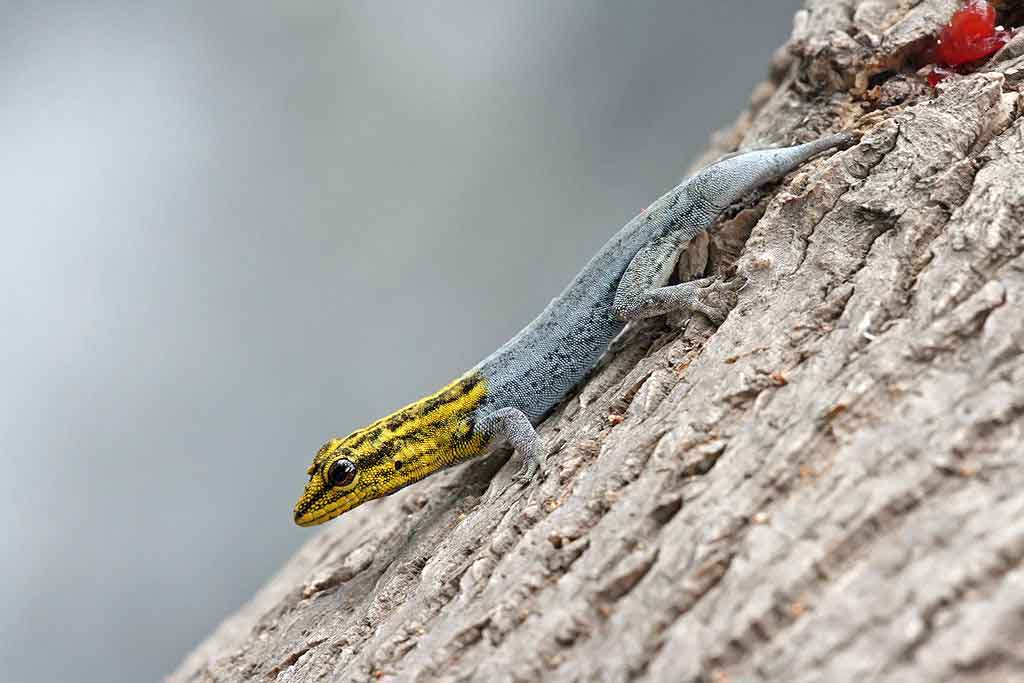
Content |
|---|
Origin and habitat
The Dwarf yellow-headed gecko is originally from Africa and lives in the border area of eastern Tanzania and southern Kenya. the subspecies zanzibaritis comes from Zanzibar.
It is a kind purely arboreal. It is found in wooded coastal areas directly on the trunks of coconut trees, in bushes and humid savannahs in small trees and shrubs.
Juveniles are tolerated in the group, and the male expels the young males before reaching sexual maturity.
Characteristics
It is a daytime Gecko, which lives in trees and has a rather thin appearance. The dominant color is the gray-blue throughout the body, with longitudinal lines slightly darker, more marked on the head. The head is generally clearer, and yellow depending on the individual.
Like all members of the genus Lygodactylus, have adhesive sheets on their fingers and at the bottom of the tail tip.
Sex discrimination is not difficult with an experienced eye; males have thickened tail base and are a brighter blue color than females. The maximum size is 90 mm, being 80 mm the mean.
The “Dwarf yellow-headed gecko” in captivity
The Dwarf yellow-headed gecko is widely traded in the exotic animal trade. With good care, the animal can reproduce quite easily in a terrarium.
It is a Gecko very shy, but this little creature is worth it. With patience, will not only get used to sharing the same space as you, but you can encourage him to eat directly from your hand. When it grows at all, will not measure more than 7 u 8 centimeters.
The ideal is to have a second Dwarf yellow-headed gecko living with you, as this will allow you to see their full personality. They are curious but also shy, so they will need a habitat with many places to hide and explore. Tubes, live plants and plenty of branches to climb will keep them entertained.
Terrarium
Keep in pairs in terrariums of 40 x 40 x 60 cm., although you could also keep a group of 1,2 in these tanks.
The substrate is a mixture of sand and earth.
The furniture consists of branches of various thicknesses, in addition to green plants with large leaves such as sansevieria. A large piece of cork serves to hide and lay eggs.
The terrariums are illuminated with a low consumption lamp of 7 W, a focus of 20 W and a tube of natural light.
The Temperatures are among the 24 °C and the 28 °C.
The humidity must oscillate between the 60 % and the 70 % and is achieved by periodic spraying. Animals also like to lick the water sprayed from the leaves.
The feeding is carried out of 2 to 3 times per week alternating with crickets, oven fish, bean beetles and wax moths and their caterpillars. Food is always sprinkled with Korvimin and calcium citrate. Approximately once a month it is offered to the Geckos fruit. Peach-passion fruit is especially popular.
Reproduction
The mating season begins between March and April, time when males are especially showy to impress females. After a successful mating, it is easy to see that the female develops eggs. These are clearly visible, but they are not through the abdominal wall, as is the case with the species Phelsuma.
after a few 4 weeks of gestation, the female usually lays a double clutch of eggs. For this, small openings or holes in the cork are usually used.. It is better to leave the eggs in the terrarium. After a few 60 to 70 days hatch the young 2,5 cm size. The coloration corresponds to that of the females. Males begin to change color slowly at the age of 3 to 4 months.
Young animals are reared individually in suitable containers. The vessels are furnished like the terrariums of the parents, with a mixture of sand and soil as substrate, fine twigs for climbing, small pieces of cork and small plants. They are illuminated with a low-power daylight tube, otherwise the containers overheat. Every two days the young are fed small food. Microgrowers, small oven fish and small caterpillars of wax moth are suitable for it. The ideal is “inocular” the substrate with springtails and white isopods, which are also easily eaten.
In the case of young animals, it is especially important that food is always sprinkled with Korvimin and calcium citrate, since they need calcium especially for their bone structure. They should also be provided with water every day.. After about 10 to 12 months animals are sexually mature.
For sale "Dwarf yellow-headed gecko"
Animals caught in the wild are often very weak and susceptible due to long transports and maintenance at dealerships.. Unfortunately, they are also sold too cheaply. Thus, I advise anyone who wants to acquire this species to opt for breeds in captivity. They will give you much more pleasure.
Its price in the exotic animal market ranges from 30 – 60 EUR.
Videos "Dwarf yellow-headed gecko"
|
|
|
|---|
